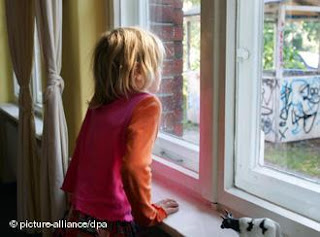"Mirrors let people see reflections of their own lives: windows let them see others' lives. Seeing oneself represented in literature engenders a sense of pride, it encourages a reader to take more interest in a book and feel a sense of involvement in literary discussions that follow a reading selection. Books that act as windows allow readers to see experiences that are different from their own lives and stretch the range of experiences that we have had." -Junko Yokota

We read to find meaning. But what is meaning? Meaning is making a connection with a text - connecting to ourselves, another text, or the world. Meaningful books are the ones we fall in love with, that we want to read again and again. According to Junko Yokota, books allow us to better understand ourselves, as well as to better understand other people and the world.
Part of teachers' and parents' jobs is to introduce children to meaningful books. Reading out loud to children is one of the best ways to model enjoyable reading and to show children possibilities for connecting with a text. Through shared reading, children can learn observation skills and inference, as well as  phonological awareness. Encouraging children to talk during a read-aloud encourages them to think more deeply about a text and to make it personally meaningful to them. Ask questions to show children that it is okay to ask questions. Talk about why the author might have written what he or she did, and think out loud about how the children might be able to write similarly.
phonological awareness. Encouraging children to talk during a read-aloud encourages them to think more deeply about a text and to make it personally meaningful to them. Ask questions to show children that it is okay to ask questions. Talk about why the author might have written what he or she did, and think out loud about how the children might be able to write similarly.
Books act as a mirror to show you parts of yourself you were not aware of; or they act as a window or doorway can take you on a trip around the world or back in time. This is the magic of books that we need to share with our young students, children, and friends. Children who have experienced the magic will be much more likely to enjoy reading for the rest of their lives, and we, as teachers and family members, have the joy of helping them begin this journey.
 What if, instead of banning toys, teachers encouraged and provided them? If this were the norm in elementary classrooms, students would have no reason to hide play - one of the most important and meaningful parts of their lives - from their teachers. Teachers who incorporate toys and play into their academics are helping their students interact with popular, cultural texts. After all, toys are texts - items to be "read," interpreted, and critiqued in different ways by different people.
What if, instead of banning toys, teachers encouraged and provided them? If this were the norm in elementary classrooms, students would have no reason to hide play - one of the most important and meaningful parts of their lives - from their teachers. Teachers who incorporate toys and play into their academics are helping their students interact with popular, cultural texts. After all, toys are texts - items to be "read," interpreted, and critiqued in different ways by different people. Including toys in the classroom during reading and writing workshops can provide focus and inspiration to students. We never know what might be the key to unlocking a child's love of literacy, and giving students the opportunity to work with toys, stories, or characters they already know and love gives them more chances for personally and culturally meaningful literacy experiences.
Including toys in the classroom during reading and writing workshops can provide focus and inspiration to students. We never know what might be the key to unlocking a child's love of literacy, and giving students the opportunity to work with toys, stories, or characters they already know and love gives them more chances for personally and culturally meaningful literacy experiences. Rather than fear distractions caused by toys at school, teachers should embrace the opportunity for students to play into literacy. Teachers will learn more about their students and students will learn to navigate through a complex literacy world outside of leveled readers and generic texts.
Rather than fear distractions caused by toys at school, teachers should embrace the opportunity for students to play into literacy. Teachers will learn more about their students and students will learn to navigate through a complex literacy world outside of leveled readers and generic texts.




